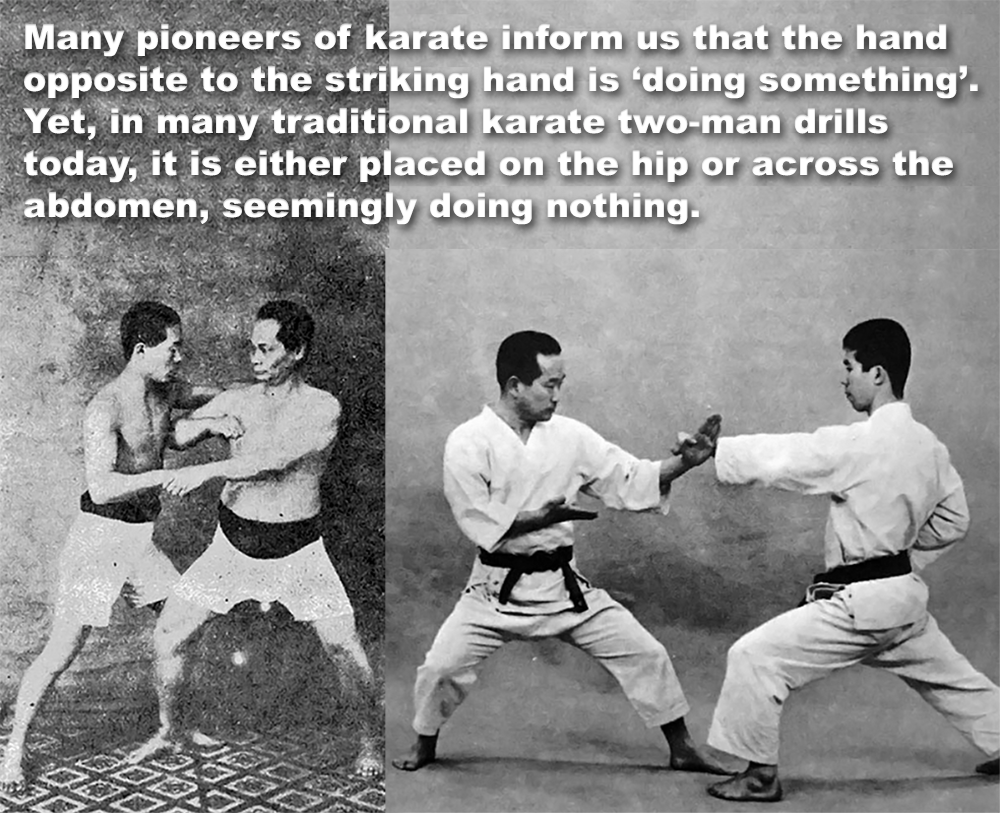
(2 minutes 15 second read)
It’s very common in traditional karate to see practitioners performing a technique, while pulling back/drawing back the other hand and placing it on the hip, or with the knife hand, across the abdomen.
.
In Japanese, the ‘pulling hand’ is called ‘hikite’, and it’s evident in most of the receiving techniques and strikes used throughout karate.
.
Seikichi Toguchi (Goju-Ryu) wrote: “When pulling a hand to the hip, it should be considered to have some part of the opponent in its grip. e.g. an arm, wrist or even head.”
.
Further to the use of ‘hikite’ is the principle of using both hands together, ’Meotode’, literally meaning “husband and wife hands”.
.
In close-quarter pragmatic karate, both hands should be used together. It’s a way of protecting yourself, or for trying to control the attacker, by utilizing both arms and hands equally, continuously attacking and receiving.
.
So when combining ‘hikite’ and ‘meotode’ there is an implication that both our hands should always be active. In other words the free hand, the non striking hand, should be doing something too.
.
Studies have shown that one of the most common habitual acts of violence is a ‘haymaker’ (swinging punch). Yet how many actually practice defending against this type of attack? The studies also show that this is often done in conjunction with a push or a grab with the opposite hand.
.
So why would an attacker grab you when they are trying to hit you?
.
They do so to disrupt your posture, prevent your escape, clear a path for strikes, and aid in identifying your whereabouts amidst the chaos of a conflict through tactile sensation..… This too is precisely how we should harness its potential.
.
If a non-trained individual instinctively knows how to use the non-punching hand, don’t you think the early pioneers used this reflex action to good effect too?
.
Why? Because it works!
.
I think it’s fair to say, that the creators of karate took natural reflex movements that most of us do instinctively, and enhanced them to make them more effective.
.
Choki Motobu was clear, we should never have “dead hands”. Gichin Funakoshi wrote; “The meaning of the ‘hikite’ is to grab the enemy’s arm and twist and pull as much as possible in order to break the enemy’s posture.”
.
Many pioneers of karate inform us that the hand opposite to the striking hand is ‘doing something’. Yet, in many traditional karate two-man drills today, it is either placed on the hip or across the abdomen, seemingly doing nothing.
.
Karate has undergone many changes over the years, where today, sport, aesthetics and formality have become the prevailing methods over any practical system. Many of the techniques taught are highly ineffective when used against anything other than karate-ka vs karate-ka attacks and defenses.
.
Making use of a ‘dead hand’ makes perfect practical sense and addresses the common inquiry posed by non-karate practitioners: “Why is the rear hand often chambered at the hip or abdomen?”
.
In my opinion, the true value of ‘hikite’ lies in its practical application. Grasping its purpose will help you adapt to real-world threats and by integrating this concept into your training, you can reveal its effectiveness in genuine self-defense situations.
